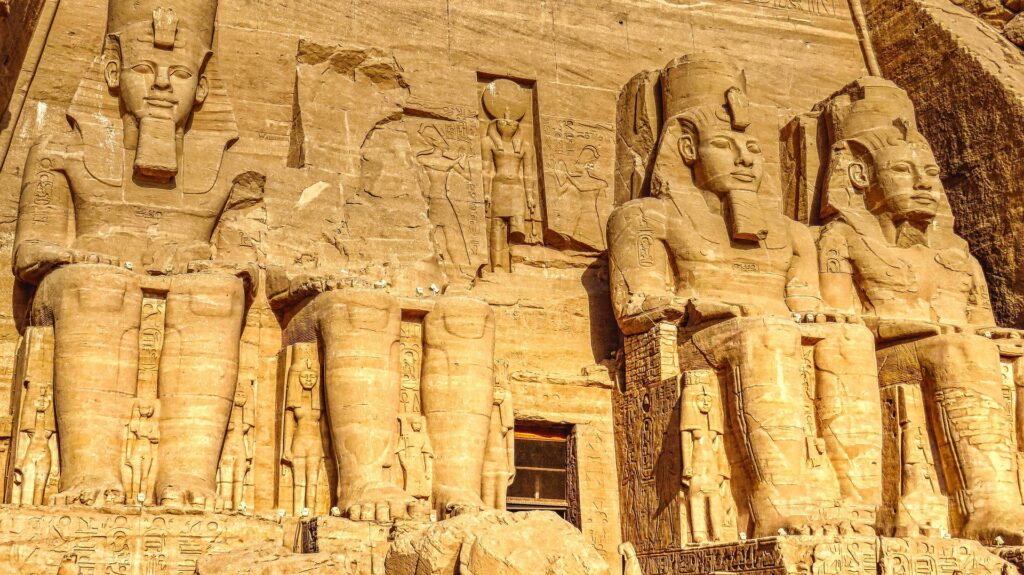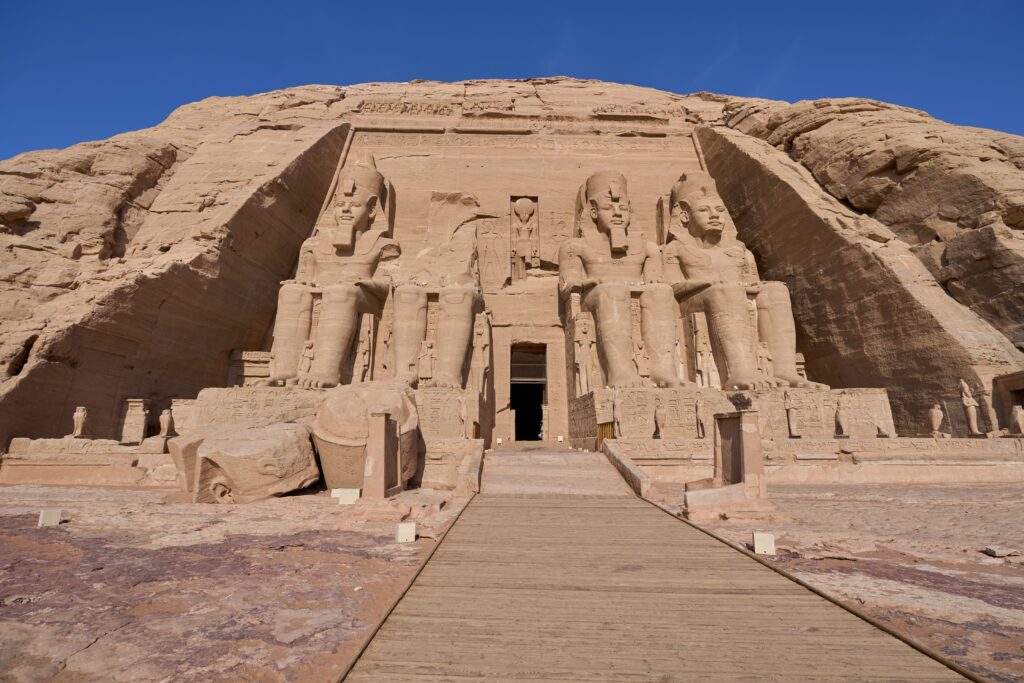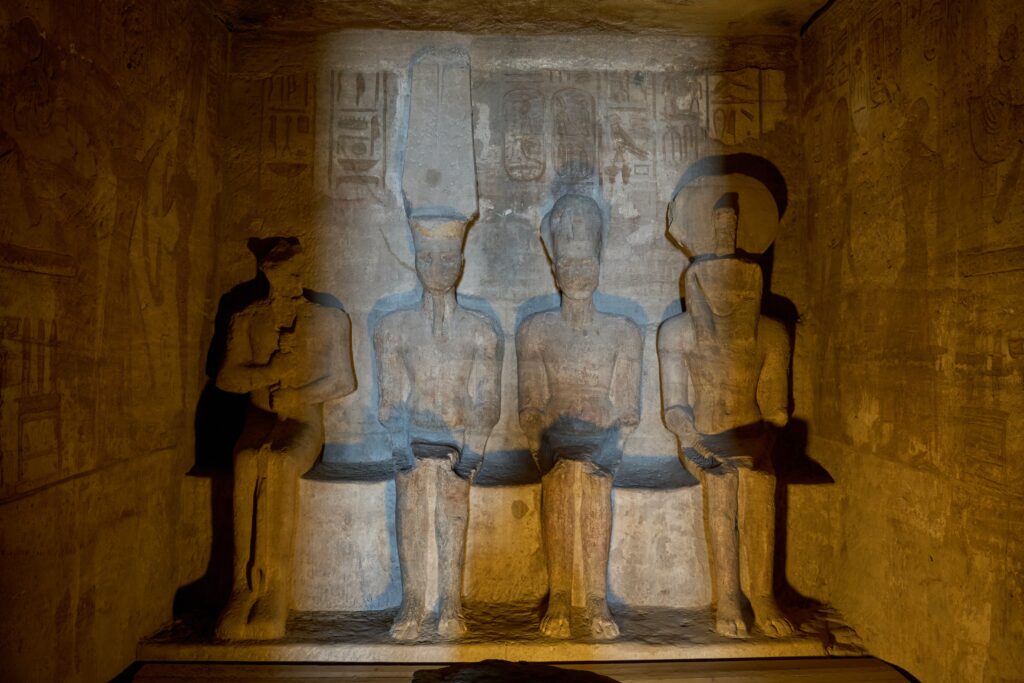Abu Simbel, a small village situated on the banks of the Nile River in southern Egypt, is home to two of the most magnificent temples of the ancient world. The Abu Simbel temples, dedicated to the Pharaoh Ramses II and his wife Queen Nefertari, are masterpieces of ancient Egyptian architecture and a testament to the grandeur and power of the pharaohs of the time. These temples continue to awe and inspire visitors with their colossal size, intricate carvings, and historical significance.

The temples were built during the reign of Ramses II, one of the most powerful pharaohs in ancient Egypt, in the 13th century BCE. The main temple, also known as the Great Temple of Ramses II, is dedicated to the worship of the gods Ra-Horakhty, Amun, and Ptah. It stands as a symbol of Ramses II’s might and his devotion to the gods.
More:Read About On Immersing in the Vibrant Atmosphere of Marrakech
As you approach the temples, a sense of awe and wonder washes over you. The sheer size of the structures is overwhelming. The main temple, carved out of a sandstone cliff, measures an impressive 108 feet in height. Its facade features four colossal statues of Ramses II seated on a throne, each reaching a towering 65 feet in height. These statues are a clear demonstration of his divinity and power.

The dedication and attention to detail in the carvings on the temple walls are truly remarkable. As you enter the main temple, you are greeted by a corridor adorned with intricate reliefs depicting Ramses II’s military victories and the worship of the gods. Each scene is meticulously carved, showcasing the artistic skills of the ancient Egyptians. The attention to detail is evident in the fine lines and delicate expressions of the figures, portraying a sense of life and movement frozen in stone.
One of the most breathtaking aspects of the temples is the phenomenon known as the “Sun Festival.” Twice a year, on February 22nd and October 22nd, the entire inner sanctum of the main temple is illuminated by the sun, except for the statue of Ptah, the god of the underworld. The precision of the alignment of the temple and the sun’s position is a marvel of ancient engineering. This solar alignment highlights the religious significance of the temples and their connection to the sun god Ra-Horakhty.
More: Wanted to download Odisha Magazines, visit here
The smaller temple, dedicated to Queen Nefertari, is no less impressive. The facade features six statues of Ramses II and Nefertari, each standing at a height of 33 feet. These statues portray the pharaoh and his queen as equals, a testament to Ramses II’s deep affection for his wife. The interior of the temple is adorned with beautiful wall paintings showcasing the achievements and religious rituals of the queen.

The Abu Simbel temples not only serve as embodiments of artistic and architectural brilliance but also carry immense historical significance. The relocation of the temples in the 1960s is an incredible feat of engineering and a testament to the international effort to preserve these ancient treasures. The construction of the Aswan High Dam threatened to submerge the temples under the waters of Lake Nasser. As a result, UNESCO launched a campaign to save them. The entire complex was painstakingly cut into blocks and relocated to higher ground, where it stands today. This rescue mission saved the temples from being lost forever.
Visiting Abu Simbel is a journey back in time, a chance to witness the splendor and opulence of ancient Egypt. The intricate carvings, the colossal statues, and the historical significance of the temples leave a lasting impression on all who have the privilege of marveling at them. The grandeur and devotion to the gods displayed in every detail of these temples are a testament to the power of the pharaohs and the enduring legacy of ancient Egypt.

In conclusion, the Abu Simbel temples, with their colossal size, intricate carvings, and historical significance, continue to captivate and inspire visitors from around the world. These ancient marvels stand as a testament to the grandeur and power of the pharaohs of ancient Egypt. The meticulous craftsmanship and the religious symbolism exhibited in every detail of the temples showcase the artistic brilliance of the ancient Egyptians. A visit to Abu Simbel is an experience of awe and wonder, offering a glimpse into the glorious past of one of the world’s most fascinating civilizations.
FAQ For Ancient Grandeur: Marveling at Abu Simbel’s Temples
Where are the Abu Simbel Temples located?
The Abu Simbel Temples are located in southern Egypt, near the border with Sudan, on the western bank of Lake Nasser.
How far is Abu Simbel from Cairo?
Abu Simbel is approximately 640 kilometers (398 miles) south of Cairo. It is recommended to take a domestic flight from Cairo to reach Abu Simbel conveniently.
What is the significance of the Abu Simbel Temples?
The Abu Simbel Temples are renowned for their historical and cultural significance. They were built by King Ramses II in the 13th century BCE to commemorate his victory at the Battle of Kadesh and to honor the gods Amun-Ra, Ra-Horakhty, and Ptah. The temples are considered a marvel of ancient Egyptian architecture and are recognized as a UNESCO World Heritage Site.
Can visitors enter the Abu Simbel Temples?
Yes, visitors are allowed to enter the Abu Simbel Temples and explore their interior. The temples are open to the public, allowing visitors to witness the intricate carvings, sculptures, and hieroglyphs within.
Are there any restrictions on photography inside the temples?
Yes, photography is generally permitted inside the Abu Simbel Temples for personal use. However, the use of flash photography is usually prohibited to preserve the delicate artwork. It is always best to check with the local authorities or guides for any specific photography restrictions at the time of the visit.
What is the best time to visit Abu Simbel’s Temples?
The most popular time to visit the Abu Simbel Temples is during sunrise or sunset when the light dramatically illuminates the facade of the temples. Additionally, it is recommended to plan the visit during the cooler months, from October to April, to avoid extreme heat.
How long does it take to explore the Abu Simbel Temples?
Exploring the Abu Simbel Temples typically takes around 1 to 2 hours, depending on the level of interest and engagement with the details. This duration includes visiting both the Great Temple of Ramses II and the smaller Temple of Hathor.
Is there any accommodation available near the Abu Simbel Temples?
Yes, there are a few hotels and accommodations available in the vicinity of the Abu Simbel Temples, ranging from budget-friendly options to more luxurious resorts. It is advisable to book in advance, especially during peak tourist seasons.

